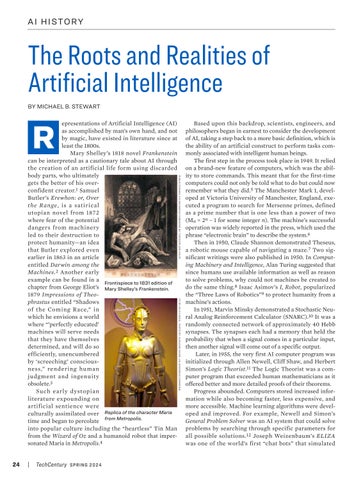AI H ISTORY
The Roots and Realities of Artificial Intelligence BY MICHAEL B. STEWART
R
|
TechCentury S P R I N G 2 0 2 4
CC BY-SA 2.0 DEED. . PHOTO BY JIUGUANG WANG. VIA WIKIMEDIA COMMONS.
24
PUBLIC DOMAIN, VIA WIKIMEDIA COMMONS. BY THEODOR VON HOLST.
epresentations of Artificial Intelligence (AI) as accomplished by man’s own hand, and not by magic, have existed in literature since at least the 1800s. Mary Shelley’s 1818 novel Frankenstein can be interpreted as a cautionary tale about AI through the creation of an artificial life form using discarded body parts, who ultimately gets the better of his overconfident creator.1 Samuel Butler’s Erewhon: or, Over the Range, is a satirical utopian novel from 1872 where fear of the potential dangers from machinery led to their destruction to protect humanity—an idea that Butler explored even earlier in 1863 in an article entitled Darwin among the Machines. 2 Another early example can be found in a Frontispiece to 1831 edition of chapter from George Eliot’s Mary Shelley’s Frankenstein. 1879 Impressions of Theophrastus entitled “Shadows of the Coming Race,” in which he envisions a world where “’perfectly educated’ machines will serve needs that they have themselves determined, and will do so efficiently, unencumbered by ‘screeching’ consciousness,” rendering human judgment and ingenuity obsolete.3 Such early dystopian literature expounding on artificial sentience were culturally assimilated over Replica of the character Maria time and began to percolate from Metropolis. into popular culture including the “heartless” Tin Man from the Wizard of Oz and a humanoid robot that impersonated Maria in Metropolis.4
Based upon this backdrop, scientists, engineers, and philosophers began in earnest to consider the development of AI, taking a step back to a more basic definition, which is the ability of an artificial construct to perform tasks commonly associated with intelligent human beings. The first step in the process took place in 1949. It relied on a brand-new feature of computers, which was the ability to store commands. This meant that for the first-time computers could not only be told what to do but could now remember what they did.5 The Manchester Mark 1, developed at Victoria University of Manchester, England, executed a program to search for Mersenne primes, defined as a prime number that is one less than a power of two (Mn = 2n − 1 for some integer n). The machine’s successful operation was widely reported in the press, which used the phrase “electronic brain” to describe the system.6 Then in 1950, Claude Shannon demonstrated Theseus, a robotic mouse capable of navigating a maze. 7 Two significant writings were also published in 1950. In Computing Machinery and Intelligence, Alan Turing suggested that since humans use available information as well as reason to solve problems, why could not machines be created to do the same thing.8 Isaac Asimov’s I, Robot, popularized the “Three Laws of Robotics”9 to protect humanity from a machine’s actions. In 1951, Marvin Minsky demonstrated a Stochastic Neural Analog Reinforcement Calculator (SNARC).10 It was a randomly connected network of approximately 40 Hebb synapses. The synapses each had a memory that held the probability that when a signal comes in a particular input, then another signal will come out of a specific output. Later, in 1955, the very first AI computer program was initialized through Allen Newell, Cliff Shaw, and Herbert Simon’s Logic Theorist.11 The Logic Theorist was a computer program that exceeded human mathematicians as it offered better and more detailed proofs of their theorems. Progress abounded. Computers stored increased information while also becoming faster, less expensive, and more accessible. Machine learning algorithms were developed and improved. For example, Newell and Simon’s General Problem Solver was an AI system that could solve problems by searching through specific parameters for all possible solutions. 12 Joseph Weizenbaum’s ELIZA was one of the world’s first “chat bots” that simulated
